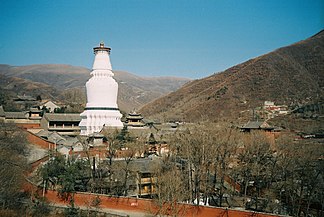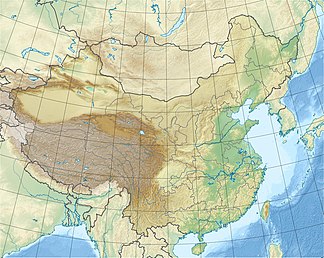Wutai Shan
| Wǔtái Shān | ||
|---|---|---|
|
View of the village of Taihuai, located between the five peaks, view of the Tayuan Si |
||
| Highest peak | Beitaiding ( 3061 m ) | |
| location | Shanxi ( PR China ) | |
|
|
||
| Coordinates | 39 ° 1 ′ N , 113 ° 36 ′ E | |
| Tibetan name |
|---|
|
Tibetan script :
རི་ བོ་ རྩེ་ ལྔ །
|
|
Wylie transliteration : ri bo rtse lnga
|
|
Pronunciation in IPA : [
riwo tseŋa ]
|
|
Official transcription of the PRCh : Riwo Zênga
|
|
THDL transcription : Riwo Tsenga
|
| Chinese name |
|
Traditional :
五臺山
|
|
Simplified :
五台山
|
|
Pinyin : Wǔtái Shān
|
The Wutai Shan ( 五臺山 / 五台山 , Wǔtái Shān , literally "Five-Terrace Mountain"), historically also called Qingliang Shan ( 清凉山 , Qīngliáng Shān , literally "Fresh Cool Mountain"), is a mountain range in northern China .
It is of great importance for Buddhism and is one of the four holy mountains of Buddhism in ancient China , along with the Emei Shan , the Putuo Shan and the Jiuhua Shan . In June 2009, the Wutai Shan was in the list of World Heritage ( World Heritage List of the) UNESCO added.
geography
The Wutai Shan is located in the northeast of Shanxi Province . The mountain range covers an area of over 260 square kilometers and is named after the "five peaks" around the village of Taihuai 台 怀 . The highest peak is the 3,061 m high North Summit ( Beitaiding ), which is also the highest peak in northeast China. Since the temperatures in summer are only around 9 ° C on average, it is also called "cool mountains".
Significance for Buddhism
The Wutai-Shan mountain range is considered the most important of the four sacred mountains of Chinese Buddhism ; there are numerous monasteries and temples around Taihuai. The history of pilgrimages to Wutai Shan spans about 2000 years. Not only did Chinese emperors travel to the mountains several times, but also pilgrims from Japan, Korea, India, Tibet and Mongolia. Famous temples include the Foguang Temple (Wutai) and the Nanchan Temple with its famous Great Hall, one of the oldest preserved structures in China.
The monasteries at Wutai Shan were so important that depictions of them were found on frescoes in Dunhuang , more than 1,600 miles away. A large number of the monasteries can be assigned to Tibetan Buddhism .
The 13th Dalai Lama (Thubten Gyatsho) spent more than half a year at Wutai Shan in 1909 on his trip to Beijing .
Residence of the Bodhisattva of Wisdom Manjushri
The Wutai Shan with its five highest peaks (also called five-finger mountain) is considered by many Buddhists to be the residence of the Bodhisattva Manjushri ( Chinese 文殊 , Pinyin wén shū , W.-G. Wen-shu ). According to tradition, Buddha Shakyamuni is said to have emitted yellow light from India to Mount Wutai Shan, whereupon the Bodhisattva Manjushri, the Lord of Wisdom , manifested himself . This was done in order to win the people of China to the teachings of Buddhism in the future. Manjushri is said to have spread Buddhist teaching in China.
- The "youthful Manjushri" should have his seat on the central summit,
- on the eastern peak sits "Manjushri the holder of knowledge",
- "Manjushri the Wise" is said to be enthroned on the southern summit,
- “Manjushri the Lion of Speech” is enthroned on the western summit and
- "Manjushri the Inviolable" is said to have its seat on the northern summit.
Identification with Khotan
The area around Wutai Shan is also identified in some sources as the Khotan area. This valley in China, surrounded by mountains, is said to have been an important place of worship for the Bodhisattva Manjushri and one of the few places in China where teachings of Buddhist tantra were accessible. Khotan is not only said to have been a teaching center for Tantric Buddhism, the teachings of Daoism and Chinese Chan Buddhism (Japanese: Zen ) were also accessible there.
Temple complexes
According to historical records, there were already over 200 monasteries in the area by the 6th century, few of which have survived. Today 47 are active and accessible again. The most important are:
Nanshan Si (Chinese 南山 寺)
With its earliest construction time in the Yuan Dynasty , the Nanshan Temple is one of the larger monasteries in the interior of Wutai Shan. Divided into three parts, it extends over seven terraces. The three lowest are called Jile Si (极乐寺, "Temple of Supreme Edification"); the middle terrace is called "Hall of Goodness and Virtue" (善德 堂) and the top three are called "The Land Guarding Temple" (佑 国寺).
Tayuan Si 塔院 寺
With a 56.4 m high white dagoba ( stupa ), Da Baita 大 白塔, on the side of which a smaller one rises. Buddhist scriptures in Chinese, Mongolian and Tibetan script are kept in the monastery library rising on the north side.
Other temples and monasteries
Inner Wutai Shan : Shouning Si, Bishan Si 碧 山寺, Puhua Si 普 化寺, Dailuo Ding, Qixian Si, Shifang Tang, Shuxiang Si 殊 像 寺, Guangzong Si 广 宗 寺, Yuanzhao Si圆 照 寺, Guanyin Dong, Longquan Si 龙泉寺, Luomuhou Si 罗睺 寺, Jinge Si 金 阁 寺, Zhenhai Si 镇海 寺, Wanfo Ge 万 佛阁, Guanhai Si, Zhulin Si, Jifu Si Gufo Si u. a.
Outer Wutai Shan : Yanqing Si, Nanchan Si, Mimi Si, Foguang Si, Yanshan Si, Zunsheng Si, Guangji Si, etc.
World Heritage
The Wutai Shan area has been included in the World Heritage List due to several outstanding properties. These are the long-lasting development under the mutual influence of the landscape and religious architecture, its quality as an extraordinary testimony to a cultural tradition and an architectural and landscape development that depicts a significant section of human history. Another outstanding feature is the cultural and religious importance of the area. The registered area has an area of 18,415 ha , it is surrounded by a 42,312 ha buffer zone.
The village of Táihuái was demolished and relocated in 2008–13 in order to free the inner world heritage site of settlements. A park was created. New houses were made available to the compensated residents in Jīngǎngkù (金 崗 23), 23 km away.
See also
literature
- Christoph Baumer: Wutai Shan is the focus of Chinese Buddhism. Monasteries and pilgrims on the holiest mountain in China. Detjen-Verlag, Hamburg 2008, ISBN 978-3-937597-29-4
- dzNyva-na-shrvi-man, History of Mt. Wutai: the Seat of Manjusri, Qinghai Nationalities Publishing House, Xining, July 1994. ISBN 7-5420-0451-4 .
- Josef Guter: Lexicon of the gods and symbols of the ancient Chinese. Marix, Wiesbaden 2004, ISBN 3-937715-04-5 , pp. 355-356
- Damien Keown: Lexicon of Buddhism. Patmos, Düsseldorf 2005, ISBN 3-491-72488-0 , pp. 296-297
Web links
- Gary Tuttle: Tibetan Buddhism at Ri bo rtse lnga / Wutai shan in Modern Times ( Memento from November 2, 2007 in the Internet Archive )
- Mount Wutai . Information about the Wutai Shan at UNESCO
Footnotes and individual references
- ↑ Damien Keown: Lexicon of Buddhism. P. 297
- ↑ http://www.panoramio.com/photo/26137602
- ↑ Josef Guter: Lexicon of the gods and symbols of the ancient Chinese. P. 355
- ↑ Patricia Buckley Ebrey: The Cambridge Illustrated History of China. (German: The Illustrated History of China by Cambridge Verlag. ) Cambridge University Press, 1996, p. 122.
- ↑ Patricia Buckley Ebrey: The Cambridge Illustrated History of China. Cambridge University Press, 1996, p. 123.
-
↑ Wang Jiawei, Nyima Gyaincain: The Historical Status of China's Tibet . China Intercontinental Press, Beijing 1997, pp. 100-102;
Thomas Laird: The Story of Tibet. Conversation With the Dalai Lama . Grove Press, New York 2007, p. 231. - ↑ Josef Guter: Lexicon of the gods and symbols of the ancient Chinese. P. 356
- ↑ Mount Wutai . Information about the Wutai Shan at UNESCO
- ^ Shepherd, Robert J .; Faith in heritage: displacement, development, and religious tourism in contemporary China; Walnut Creek, Calif. 2013 (Left Coast Press); ISBN 978-1-61132-073-2 ; Cape. IV


